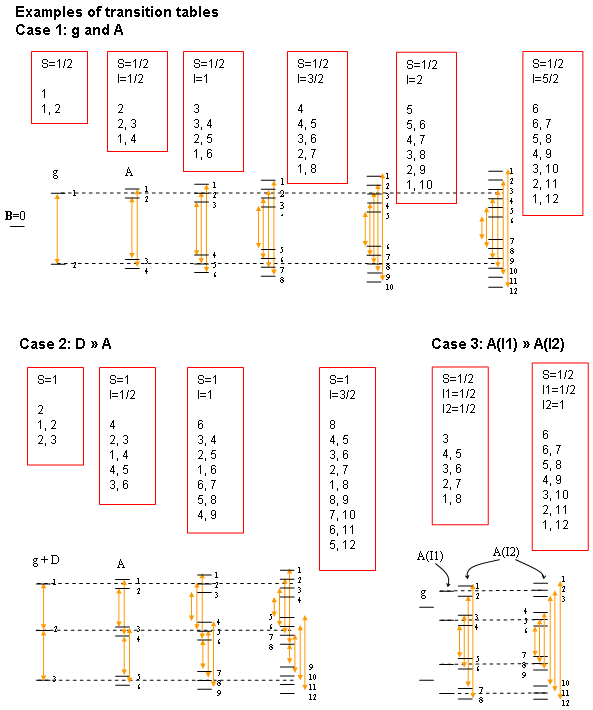matrix
2 2, 3 1, 4 2 2, 3 1, 4 2 2, 3 1, 4 2 2, 3 1, 4 2 2, 3 1, 4 … |
#1 ransition between 2nd and 3rd levels ransition between 1st and 4th levels #2 #3 #4 #5 |
What are transition tables?
When we execute the EPR-NMR program, the given SH matrices are numerically diagonalized, and finally we will obtain energy levels (=eigenvalues). In order to calculate an angular map or EPR spectrum, we have to specify which transition(=energy difference) we observe. You can specify not only EPR-allowed transitions (ΔMS=±1/2, ΔMI=0) but also forbidden transitions (ΔMS=±1/2, ΔMI=±1/2) or NMR transitions (ΔMS=0, ΔMI=±1/2). For many cases, it will be enough to specify only EPR-allowed transitions.
In below, typical transition tables for the allowed transitions are given. You can use them by cut-and paste.
But, note that these examples are not always valid. In particular, for Cases 2 and 3, transition tables are considerably changed depending on the magnitude of D and A values. This is the most troublesome problem when we use EPR-NMR. Thus, we recommend you to check always whether transition tables are correctly given or not. The easiest way will be to compare a simulated angular map or EPR spectrum with real experimental results.
Obviously, a combination of high-S and high-I (Case 2) causes a drastic complication of transition tables. Also multi-I systems (Case 3) become very complicated. So, to avoid such complications, it will sometimes be useful to separate parameter files for central lines (g and D) from those for hyperfine (A) splitting. An example can be seen in the case of the P2 center in Si (Si/V2-O2/P2si_only.inp).
The number of transition tables should equal to NSITE(= the number of rotation matrices). Each transition table should be separated by empty line(s).
In each table, the first line specifies the number (N) of transitions you want to calculate. Then, N transitions between nth and mth levels are specified in the following lines, where n and m should be separated by comma “,” or space(s).
